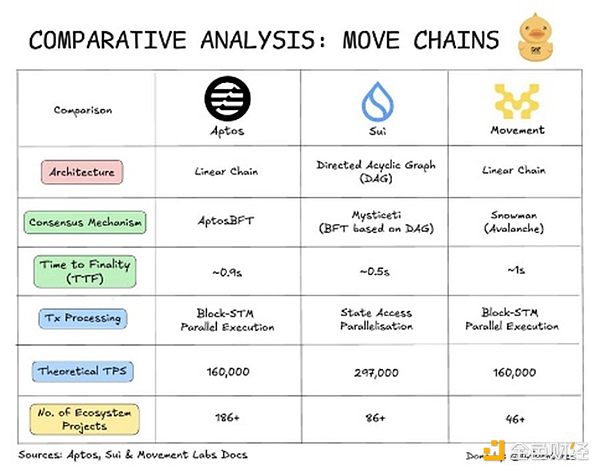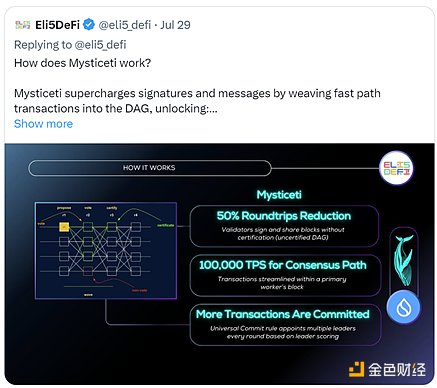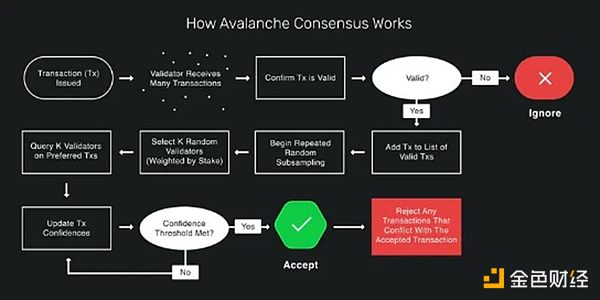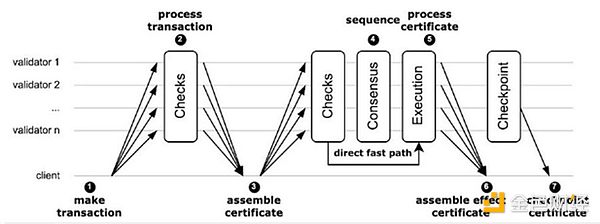Author: DWF Ventures, Translation: Golden Finance xiaozou
Public chains Aptos and Sui are rapidly gaining attention, and the upcoming Movement is also showing significant growth on the testnet.
These three public chains all use the Move language, but what is the real difference between them?
Let’s look at it in detail below.

1 , Architecture
Aptos and Movement are both linear blockchains, meaning blocks are arranged sequentially and state is updated incrementally through batch transactions.
The DAG structure on Sui is like a network of interconnected nodes, and transactions can independently reach consensus, ensuring high throughput.

2 , Consensus and TTF
All chains use some form of Byzantine Fault Tolerance (BFT) protocol.
AptosBFT improves efficiency by allowing nodes to communicate only with ldader (leader rotation is conducted through voting).
Sui's Mysticeti allows a single validator to sign blocks and appoint multiple leaders, allowing more transactions to be submitted per block.
 Movement uses Avalanche's Snowman consensus mechanism and must Meets the condition of a majority of a subset of validator samples and introduces delays in case of conflicting decisions.
Movement uses Avalanche's Snowman consensus mechanism and must Meets the condition of a majority of a subset of validator samples and introduces delays in case of conflicting decisions.
These mechanisms affect the TTF of the chain (referring to the time it takes for a transaction signal to start broadcasting and reach the final state). Among them, Sui's average TTF is about 0.5 seconds, which is the fastest.

3 , Transaction Processing and TPS (Transactions Per Second)
All chains use parallel execution, Supports simultaneous processing of conflict-free transactions.
Aptos and Movement use the Block-STM optimistic parallel execution engine, which assumes that all transactions can be executed in parallel and will be re-executed in the case of incorrect transactions.

Sui uses such a A state access method: Sort according to the transaction object transaction to ensure that the transaction can run without conflicts after being successfully verified by the validator.
As a result, Sui is able to process transactions more efficiently without the need for re-execution, thereby reducing hardware load to improve TPS.
 4, Ecosystem
4, Ecosystem
Aptos has been running for a long time. Compared with Sui and Movement, Aptos has more Ecosystem Project.
All chains have done a lot of solid work on builder support and funding programs, which may lead to significant growth in the coming months.
In summary, DWF Investment believes that the Move ecosystem will continue to grow rapidly, and we are excited to see more further developments. Projects built within the Move ecosystem can contact us at any time.
 JinseFinance
JinseFinance



 Movement uses Avalanche's Snowman consensus mechanism and must Meets the condition of a majority of a subset of validator samples and introduces delays in case of conflicting decisions.
Movement uses Avalanche's Snowman consensus mechanism and must Meets the condition of a majority of a subset of validator samples and introduces delays in case of conflicting decisions. 

 4, Ecosystem
4, Ecosystem

